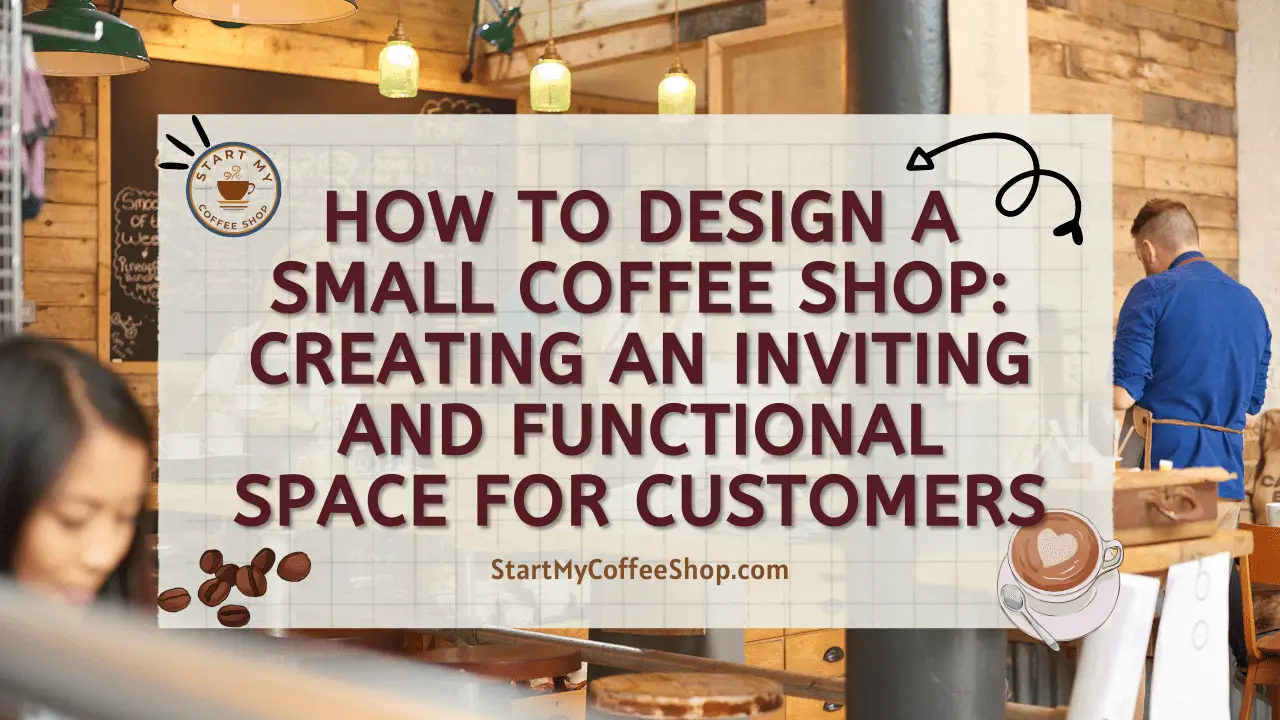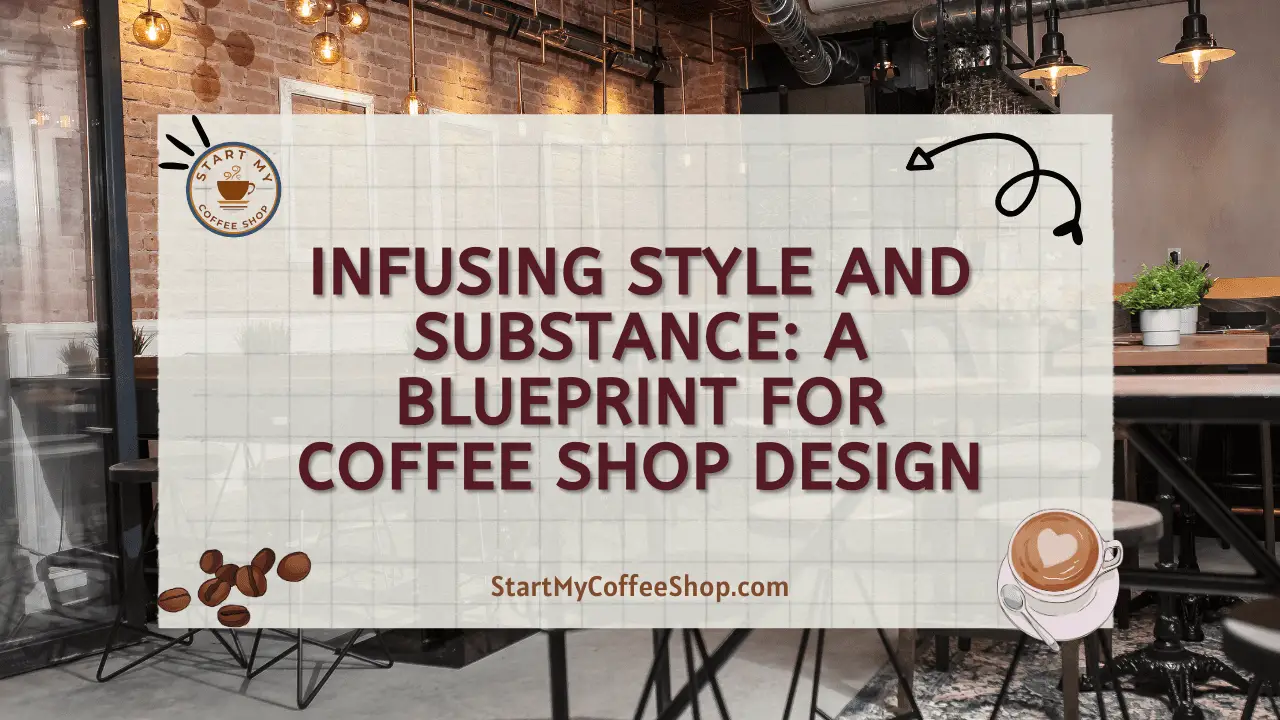When it comes to designing a small coffee shop, several key steps and considerations can help create an inviting and functional space for customers. From planning the layout to selecting furniture and decor, every decision plays a crucial role in shaping the overall ambiance and customer experience.
The key steps in designing a small coffee shop include: planning the layout, considering seating arrangements, optimizing workflow, selecting appropriate furniture and decor, ensuring proper lighting and ventilation, and incorporating branding elements for a cohesive and inviting atmosphere.
In this article, I will explore the essential elements and best practices involved in designing a small coffee shop that attracts and delights customers.
Planning the Layout
The layout of a coffee shop is not just about aesthetics; it plays a crucial role in the overall functionality and efficiency of the space. Careful consideration of customer flow, work triangle, and accessibility is vital when planning the layout.
When analyzing the space, envision how customers will move through it. It is important to create a logical flow that minimizes congestion and allows for easy navigation between different areas.
Consider the placement of the ordering counter, seating, and restrooms to ensure a smooth and comfortable experience for customers. By strategically positioning these areas, you can optimize customer flow and prevent bottlenecks.
The work triangle is another key aspect of the coffee shop layout. It refers to an efficient arrangement of the barista station, espresso machine, and point-of-sale area. By creating a compact triangle between these essential components, you minimize the time and effort required for baristas to prepare and serve beverages.
This arrangement enhances workflow and reduces unnecessary movements, ultimately improving efficiency and customer satisfaction.
Accessibility is an important consideration to ensure that your coffee shop is inclusive and welcoming to all customers, including those with disabilities. Make sure your layout complies with accessibility guidelines by incorporating features such as ramps, wider aisles, and accessible seating options.
These additions enable customers with mobility challenges to navigate the space comfortably and enjoy the offerings of your coffee shop without limitations.
Seating Arrangements
Creating a comfortable seating arrangement is essential for fostering a welcoming and cozy atmosphere in a coffee shop. Consider the following factors when selecting and arranging seating options:
- Firstly, space optimization is key. Maximize the use of available space by selecting versatile seating options such as chairs, booths, and bar stools. These options can be easily rearranged to accommodate different group sizes and optimize the space. By utilizing different seating heights and styles, you can cater to various customer preferences and create a visually interesting seating area.
- Secondly, flexibility is important when designing the seating area. Ensure that the seating arrangement can accommodate different group sizes. Offer a mix of seating options suitable for individuals, couples, and larger groups.
By providing a range of seating options, you cater to the diverse needs of your customers and create a welcoming environment for everyone. Consider incorporating communal tables as well, as they provide an opportunity for customers to socialize or work together, fostering a sense of community within the coffee shop.
- Lastly, prioritize comfort and ergonomics when choosing seating options. Opt for chairs with proper back support and consider ergonomic designs that promote good posture. Comfortable seating enhances the overall experience for customers, allowing them to relax and enjoy their time in the coffee shop. Incorporate cushions or upholstered seating to provide additional comfort and create a cozy ambiance.
Workflow Optimization
Efficient workflow is vital for the smooth operation of a small coffee shop. Optimizing workflow can improve productivity and customer service. Consider the following tips to maximize efficiency:
- Firstly, strategic equipment placement is crucial. Position coffee machines, grinders, and other equipment in a way that minimizes unnecessary movement. Place them within easy reach of baristas, reducing the time and effort required to prepare beverages.
Organize the workstations effectively, ensuring that essential tools and ingredients are readily accessible. This streamlines the workflow and allows baristas to work more efficiently.

- Secondly, prioritize storage and organization. Plan sufficient storage space for coffee beans, syrups, cups, and other supplies. A well-organized storage area minimizes clutter and makes it easier for staff to locate necessary items quickly. Implement a system to keep track of inventory and ensure timely restocking, reducing the chances of running out of essential supplies during peak hours.
- Lastly, design separate paths for customers and staff. This separation helps reduce congestion and enhances the overall flow of the coffee shop. Customers should have easy access to the ordering counter and seating areas without interrupting the workflow of the staff.
On the other hand, staff should have clear pathways to efficiently perform their tasks, such as preparing orders and serving customers. By minimizing the interaction between customer and staff paths, you create a more organized and efficient environment.
By implementing these workflow optimization strategies, you can enhance productivity and create a seamless experience for both staff and customers.
Read more about Cost to Open Coffee Shop Average: From Concept to Cash Register
Furniture and Decor Selection
The furniture and decor of a coffee shop play a significant role in shaping its ambiance and overall theme. When selecting furniture and decor elements, consider the following factors to create a visually appealing and cohesive atmosphere:
- Firstly, consider your coffee shop’s theme or branding. Choose furniture and decor elements that align with this theme. Whether you opt for a rustic, modern, or eclectic style, consistency is key.
From chairs and tables to wall decor and accessories, ensure that the design elements work together harmoniously to create a cohesive atmosphere that reflects your coffee shop’s unique identity.
- Secondly, prioritize materials and durability. Select furniture and decor made of durable materials that can withstand the demands of a high-traffic environment. Coffee shops are busy spaces, so it’s essential to choose items that can endure constant use.
Opt for sturdy chairs, tables, and countertops that can withstand regular wear and tear. Additionally, consider easy-to-clean surfaces and stain-resistant fabrics to maintain a clean and inviting appearance throughout the day.
- Thirdly, pay attention to lighting and color scheme. Lighting plays a crucial role in setting the mood and enhancing the aesthetic appeal of your coffee shop. Combine natural light with well-placed artificial lighting fixtures to create a warm and inviting atmosphere. Consider using different lighting levels and fixtures for different areas, such as brighter lights at the counter and softer lighting in seating areas to create a cozy ambiance.
Furthermore, choose a color scheme that complements your coffee shop’s theme and branding. Colors can evoke specific emotions and influence the overall atmosphere. Consider the psychological effects of colors and select hues that align with your desired ambiance.
Whether you prefer warm earth tones, vibrant pops of color, or a soothing palette, ensure that the chosen colors work harmoniously with the overall design concept of your coffee shop.
Lighting and Ventilation
Proper lighting and ventilation are crucial in creating a comfortable and pleasant environment for customers in a coffee shop. Consider the following tips to optimize these aspects:
- Firstly, maximize the use of natural light. Incorporate large windows or skylights in your coffee shop design to allow ample natural light to fill the space. Natural light creates a welcoming and inviting atmosphere, making customers feel more comfortable and relaxed.
Additionally, it reduces the reliance on artificial lighting during the day, helping to conserve energy and create a more eco-friendly environment.
- Secondly, utilize a combination of artificial lighting techniques. Use ambient lighting as the base layer to provide overall illumination and create a warm and inviting ambiance throughout the coffee shop.
Task lighting should be employed in specific areas, such as the ordering counter and seating areas, to provide focused illumination for tasks like reading menus or working on laptops. Accent lighting can be used to highlight certain features, such as artwork or displays, adding visual interest and creating a cozy atmosphere.
- Lastly, ensure proper airflow and ventilation. Good ventilation is essential to maintain a fresh and comfortable atmosphere for customers. Install effective ventilation systems that circulate air and remove odors.
This helps to create a pleasant environment by preventing stale air and ensuring proper air quality. Adequate ventilation also helps to regulate temperature and reduce humidity levels, making the space more comfortable for both customers and staff.
Branding and Identity
Incorporating branding elements into the design of your coffee shop is essential for creating a unique identity and reinforcing customer recognition. Consider the following strategies to effectively infuse branding into your coffee shop’s design:

- Firstly, focus on your coffee shop’s logo and signage. Display your logo prominently in key areas of the shop, such as the entrance or behind the counter. Ensure that it is easily visible and instantly recognizable.
Additionally, use clear and well-placed signage to guide customers and communicate important information. Ensure that your logo and signage are visible from inside and outside the shop, attracting attention and reinforcing brand awareness.
- Secondly, pay attention to your menu and merchandising. Design an appealing menu layout that aligns with your brand’s visual identity. Incorporate your logo, brand colors, and typography that reflect your coffee shop’s personality.
The menu should be visually attractive, easy to read, and enticingly showcase your offerings. Consider incorporating branded merchandise displays, such as mugs, t-shirts, or bags, which not only generate additional revenue but also serve as walking advertisements for your coffee shop.
- Lastly, use artwork and decor elements to enhance your coffee shop’s identity. Choose artwork and decor pieces that align with your brand’s personality, values, or local culture.
Whether it’s displaying local artwork, using unique wall decorations, or incorporating quirky elements, these details contribute to a memorable and engaging customer experience. Consistency in branding elements throughout the shop creates a cohesive and immersive environment that customers can quickly identify with.
By implementing these strategies, you can effectively incorporate branding elements into the design of your coffee shop. Creating a unique identity through logo and signage, aligning your menu and merchandising with your brand, and using artwork and decor that reflects your coffee shop’s personality all contribute to a memorable and cohesive brand experience.
Remember, strong branding enhances customer recognition, fosters loyalty, and sets your coffee shop apart from the competition.
Read more about Cost to Open Coffee Stand: Evaluating the Financial Commitment to a Coffee Stand
Summary
Designing a small coffee shop involves careful consideration of various elements to create an inviting and functional space for customers. From planning the layout and optimizing workflow to selecting furniture and decor, each decision contributes to the overall ambiance and customer experience.
By focusing on customer flow, comfort, efficiency, branding, and atmosphere, you can create a coffee shop that stands out and attracts loyal customers. Remember, the design should reflect your coffee shop’s unique identity and create a space where people can enjoy their favorite cup of coffee in a welcoming environment.
Frequently Asked Questions

1. What are the essential permits and licenses required to open a small coffee shop?
You typically need permits and licenses such as a business license, food service permit, health department approval, and possibly a liquor license if you plan to serve alcohol.
2. How do I determine the ideal seating capacity for my small coffee shop?
Consider the size of your tables, aisle width, and customer comfort. Balance the desire for maximizing capacity by ensuring a comfortable and spacious environment for your customers.
3. What equipment and supplies do I need to set up a small coffee shop?
Some essential equipment includes an espresso machine, grinders, brewing equipment, refrigeration units, a point-of-sale system, and furniture. Additionally, you’ll need coffee beans, milk, syrups, cups, lids, and various utensils.
To learn more on how to start your own coffee shop checkout my startup documents here
Please note: This blog post is for educational purposes only and does not constitute legal advice. Please consult a legal expert to address your specific needs.

Hi! I’m Shawn Chun
My adventure in coffee began when I first launched my first coffee shop back in the early 2000s. I had to figure out so many things on my own and to make it worse within 2 years of opening two large corporate coffee chains moved in just blocks away from me!
As I saw smaller and even some larger coffee shops in the neighborhood slowly lose customers to these giant coffee chains and slowly close up shop, I knew that I had to start getting creative…or go out of business.
I (like you may be) knew the coffee industry well. I could make the best latte art around and the foam on my caps was the fluffiest you have ever seen. I even had the best state-of-the-art 2 group digital Nuova Simonelli machine money could buy. But I knew that these things alone would not be enough to lure customers away from the name brand established coffee shops.
Eventually, through lots of trial and error as well as perseverance and creativity I did find a way to not only survive but also thrive in the coffee/espresso industry even while those corporate coffee chains stayed put. During those years I learned to adapt and always faced new challenges. It was not always easy, however, in the end, I was the sole survivor independent coffee shop within a 10-mile radius of my location. Just two corporate coffee chains and I were left after that year. All told the corporate coffee chains took down over 15 small independent coffee shops and kiosks and I was the last one standing and thriving.
Along the years I meet others with the same passion for coffee and I quickly learned that it is not only “how good a barista is” that makes a coffee shop successful, but the business side of coffee as well.
Hence why I started this website you are on now. To provide the tools and resources for up and coming coffee shop owners to gain that vital insight and knowledge on how to start a coffee shop successfully.
Stick around, browse through my helpful blog and resources and enjoy your stay! With lots of LATTE LOVE!
Shawn







